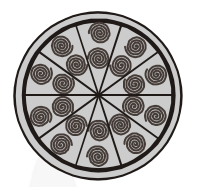A brooch is made with silver wire in the form of a circle with diameter 35 mm. The wire is also used in making 5 diameters which divide the circle into 10 equal sectors as shown in fig. Find:
(i) the total length of the silver wire required.
(ii) the area of each sector of the brooch.

Diameter of the circle = 35 mm
$\therefore \operatorname{Radius}(\mathrm{r})=\frac{\mathbf{3 5}}{\mathbf{2}} \mathrm{mm}$
(i) Circumference $=2 \pi \mathrm{r}$
$=2 \times \frac{22}{7} \times \frac{35}{2} \mathrm{~mm}=22 \times 5=110 \mathrm{~mm}$
Length of 1 piece of wire used to make diameter to divide the circle into
10 equal sectors = 35 mm
$\therefore \quad$ Length 5 pieces $=5 \times 35=175 \mathrm{~mm}$
$\therefore$ Total length of the silver wire
$=110+175 \mathrm{~mm}=285 \mathrm{~mm}$
(ii) Since the circle is divided into 10 equal sectors,
$\therefore$ Sector angle $\theta=\frac{\mathbf{3 6 0}^{\circ}}{\mathbf{1 0}}=\mathbf{3 6}^{\circ}$
$\Rightarrow$ Area of each sector
$=\frac{\theta}{360^{\circ}} \times \pi \mathrm{r}^{2}=\frac{36^{\circ}}{360^{\circ}} \times \frac{22}{7} \times \frac{35}{2} \times \frac{35}{2} \mathrm{~mm}^{2}$
$=\frac{\mathbf{1 1} \times \mathbf{3 5}}{\mathbf{4}} \mathrm{mm}^{2}=\frac{\mathbf{3 8 5}}{\mathbf{4}} \mathrm{mm}^{2}$
Click here to get exam-ready with eSaral
For making your preparation journey smoother of JEE, NEET and Class 8 to 10, grab our app now.
